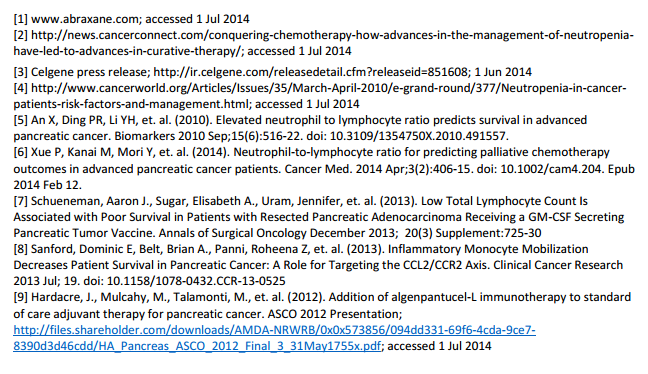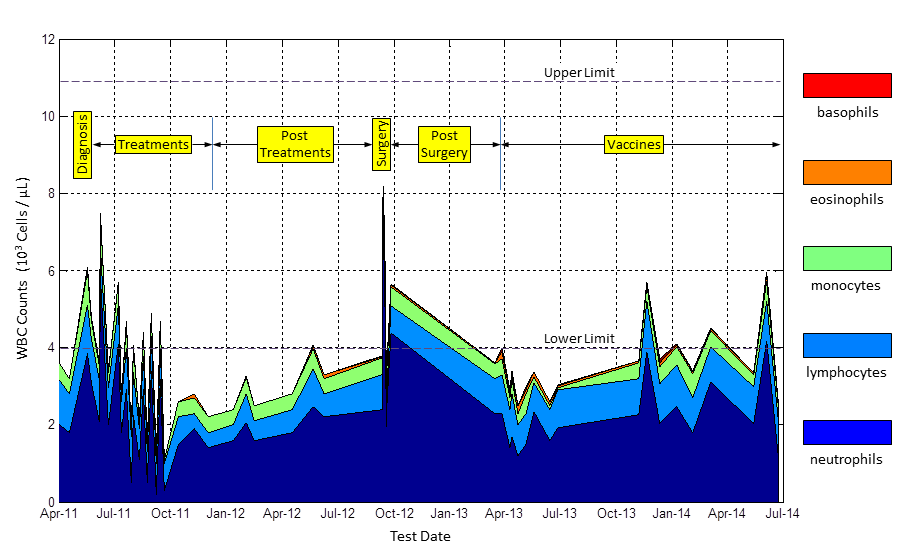WBC During Chemotherapy
What happens to WBC during chemotherapy? Standard chemotherapy drugs such as 5-FU, Abraxane, Capecitabine, Docetaxel, Gemcitabine, Irinotecan, Cisplatin, and others disrupt the cell cycle – specifically keeping most cells from dividing. In contrast, targeted therapies act on specific molecular targets present in cancerous tumors.
Examples of rapidly dividing cells affected by standard chemotherapy are blood cells (both red and white), intestinal lining, and taste buds. If you injure yourself, the wounds will not heal until the chemotherapy has left the cells. If you get sick, new white blood cells cannot be created until the chemotherapy has dissipated.
Chemotherapy treatments are spaced spaced in time to allow the body to recover. Unfortunately, the tumor cells go through the same cycle of halted division and recovery. Just like the white blood cells, tumor growth is temporarily halted each cycle.
WBC During Chemotherapy Cycle
Below, I’ll describe several stages in a cycle of chemotherapy. These are my own stages for this posting, so don’t try to match them up with some literature.
Chemotherapy treatment
The patient takes the chemotherapy agents (IV infusion or orally).
Cells absorb chemotherapy
After the chemotherapy drug(s) have entered the bloodstream, they are taken up by the cells. All cells – good and bad absorb untargeted chemotherapy. Chemotherapy agents like Gemcitabine and 5-FU disrupt the cell division process by acting like one of the four nucleobases (A, G, C, or T) and preventing the next nucleobase from attaching. This prevents the DNA or RNA from replicating. If the cell does not undergo replication while exposed to these chemotherapy drugs, they are not affected.
Cells division slows/halts
With the chemotherapy agents inside the cell, they can no longer divide and replace themselves. The tumor cannot create more tumor cells – as long as it has not mutated to block the chemotherapy agent from working.
Chemotherapy exhausted
The chemotherapy agents are eventually used up and the cells can resume dividing.
Cells division increases
Cells are still aging and dying, but now the capacity to replace them is catching back up to normal.
Body recovers
The dying cells are all replaced and the division rate of the cells is (almost) back to normal.
WBC Measurements During Chemotherapy
This table describes the sequence and dosage of each of my chemotherapy treatments. The dosages are based upon my body weight/height and changed somewhat from treatment to treatment. I’ll also note that the Cisplatin bag was labelled as light sensitive and covered to keep the room lights off of it. A few times at my local infusion center I had to remind the infusion nurses that the bag should be covered (like the label said).
Gemcitabine/Cisplatin Treatment
| Treatment | Infusion Time | Drug | Dose | Type |
|---|---|---|---|---|
| Bag 1 | 240 minutes | Potassium Chloride | 20 mEq | Electrolyte |
| Magnesium Sulfate | 9 mEq | Electrolyte | ||
| Sodium Chloride | 1000 mL | |||
| Bag 2 | 60 minutes | Dexamethasme | 2.5 mL (10 mg) | Steroid |
| Sodium Chloride | 50 mL | |||
| Bag 3 | 30 minutes | Ondansetron | 8 mL (16 mg) | Anti-nausea |
| Sodium Chloride | 50 mL | |||
| Bag 4 | 60 minutes | Gemcitabine HCL | 1074 mg | Chemotherapy |
| Sodium Chloride | 250 mL | |||
| Bag 5 | 60 minutes | Cisplatin | 54 mg | Chemotherapy |
| Sodium Chloride | 250 mL |
Below are WBC measurements taken during my nine rounds of Gemcitabine/Cisplatin chemotherapy. My treatments were given every two weeks. My initial treatments were at MD Anderson in Houston (a 5-hour drive each way) and soon I opted to have them done locally in Dallas. For the local treatment, WBC was measured during the off-treatment week and these show how the WBC drops and then rebounds.
Towards the end, my neutrophil counts were quite low, and I was given three daily shots of neupogen (480 mg each) to help boost the neutrophil production. These shots gave me bone pains which a hard to describe exactly, but they were indeed pain in the bones (spine, legs) that most closely resembled pain the day after an intense workout. I continued bike riding (which temporarily relieved the pain) and took some aspirin.
One June WBC measurement was made the day after my 2nd chemotherapy infusion. It is the highest of all the measurements and at the time, caused me to think about this WBC cycle and what was going on. I’ve never found any daily WBC measurements made on a patient going through chemotherapy to show what really happens. But at the time of this treatment (2nd of 9 cycles), I still had the capability to make white blood cells and perhaps the body was reacting to the chemotherapy. Or perhaps the steroids or anti-nausea medication had some immediate effect. I’m open to explanations.

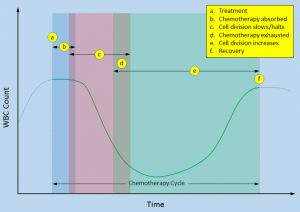
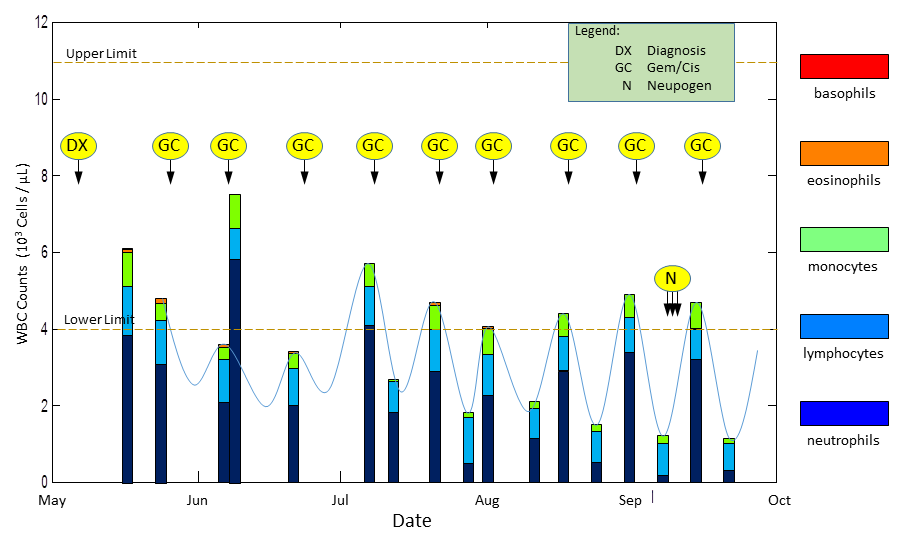
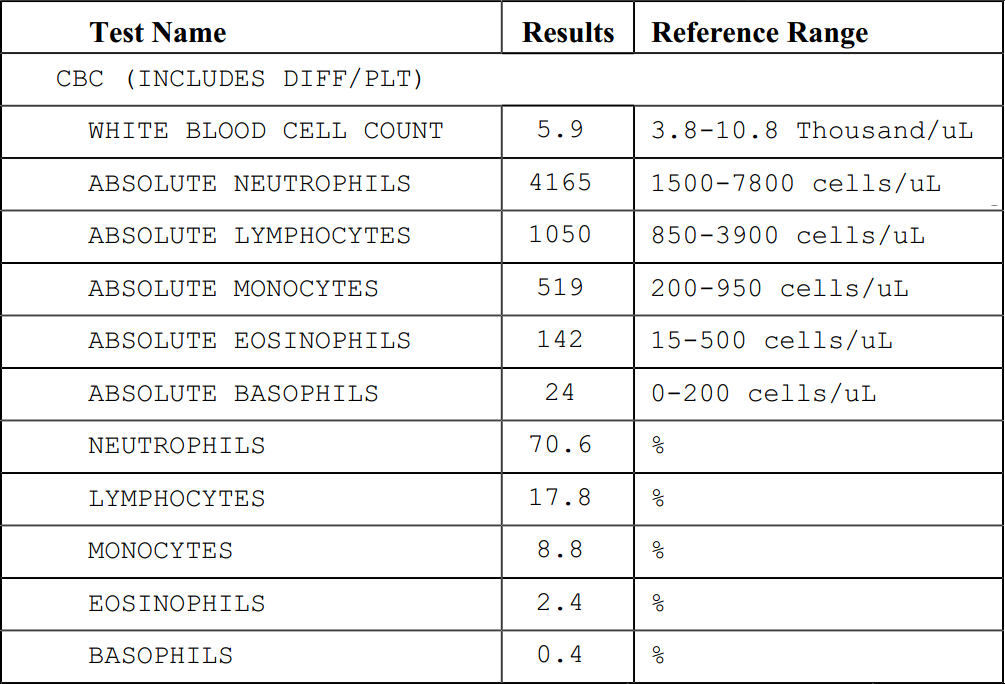 a blood test, the results will be a part of the CBC (Complete Blood Count) panel. This test measures the number of blood cells in a micro-liter of blood. I’ve extracted the meaningful lines from one of my recent CBC panels here. There is a total count at the top, followed by individual counts of the five types of white blood cells: neutrophils, lymphocytes, monocytes, eosinophils, and basophils.
a blood test, the results will be a part of the CBC (Complete Blood Count) panel. This test measures the number of blood cells in a micro-liter of blood. I’ve extracted the meaningful lines from one of my recent CBC panels here. There is a total count at the top, followed by individual counts of the five types of white blood cells: neutrophils, lymphocytes, monocytes, eosinophils, and basophils.